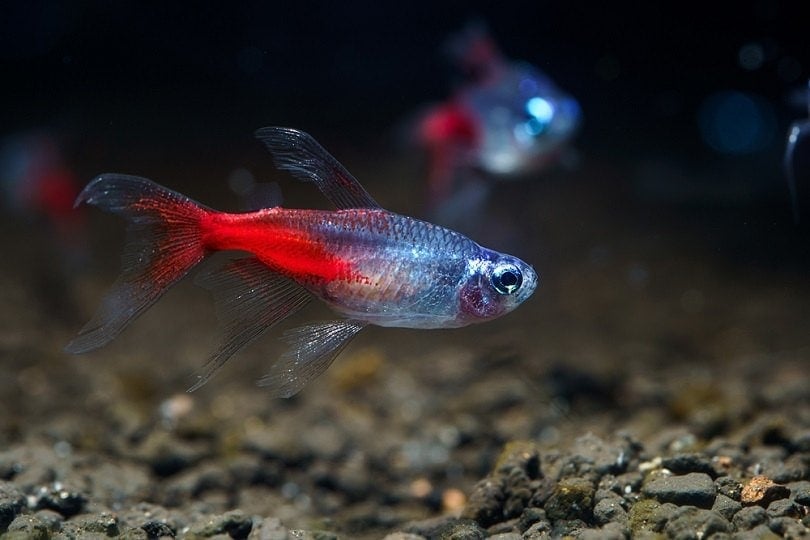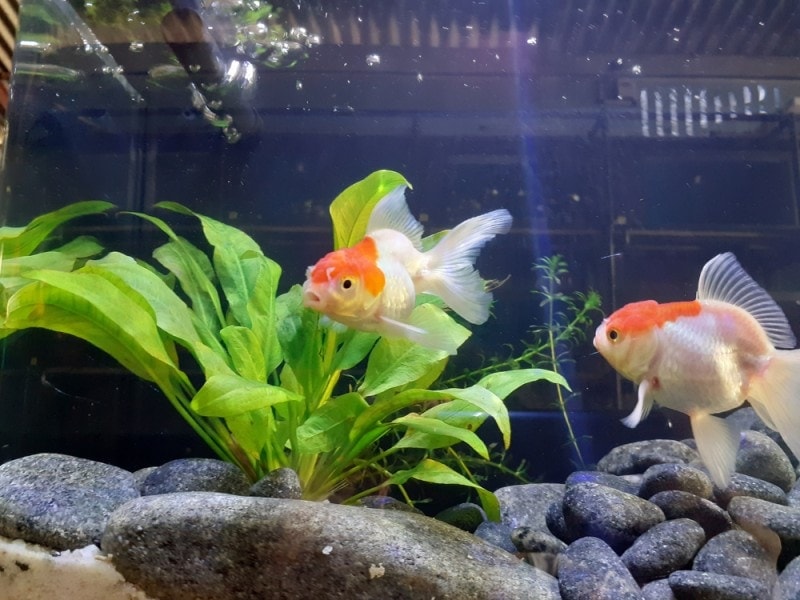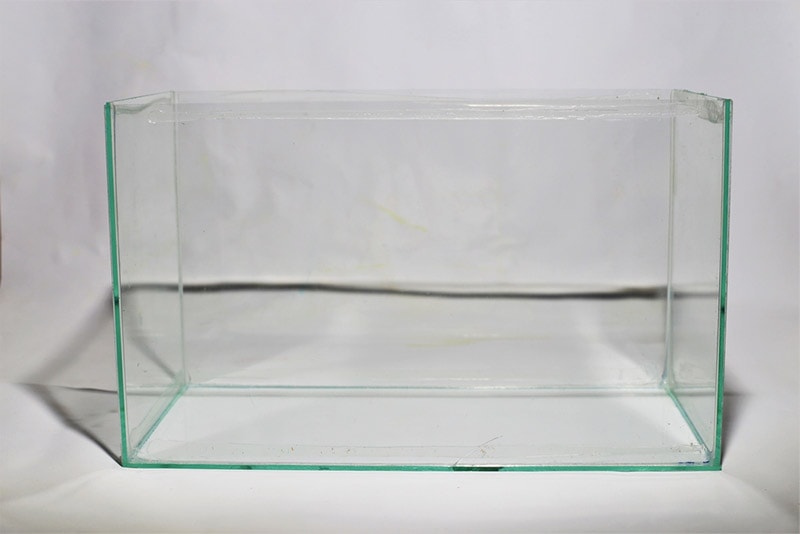8 Best Rainbow Shark Tank Mates: Vet-Approved Compatibility Guide (With Pictures)

Updated on
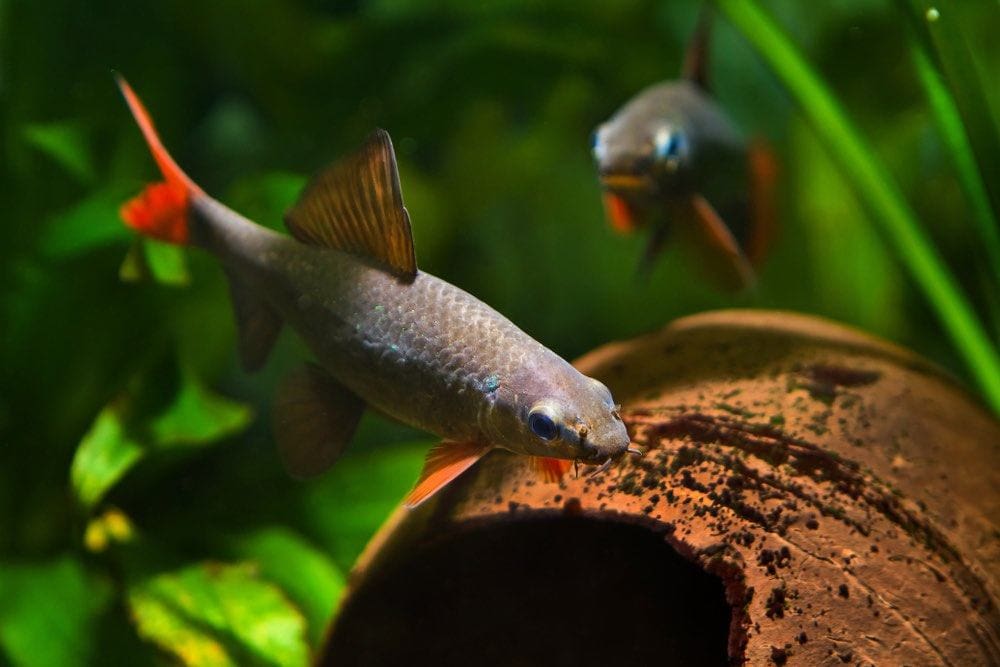
The rainbow shark is a popular fish in the aquarium trade, but don’t let the name fool you. This fish isn’t actually a shark. It belongs to the Cyprinidae family, which contains all minnows and carp species, including goldfish, true minnows, and koi. It is a semi-aggressive fish, but there are multiple suitable tank mates for the rainbow shark. Keep in mind, though, that the rainbow shark can reach 4–6 inches in length, and due to its temperament and behaviors, this fish can eat smaller tank mates and may bully singular fish that won’t stand up for themselves.
The Best Rainbow Shark Tank Mates
1. Blue Gourami

Size
5–6 inches
Diet
Omnivore
Temperament
Generally peaceful, territorial
The blue gourami is a popular gourami species, also available in other “varieties”, such as the opaline, gold, and three spot gourami. The three spot gourami name comes from the two spots this fish has on the sides of its body, with its eyes making the third spot on each side.
This omnivorous fish has a taste for meaty foods, primarily focusing on very small prey, like insect larvae and shrimps. Although generally considered to be a peaceful fish, the blue gourami will stand up for their territory, as well as their breeding rights. You can expect some aggression between males, and male blue gouramis are often known to show aggression toward other fish that are similar in appearance (such as bettas). It is best to only house one gourami per aquarium.
2. Honey/Dwarf Gourami

Size
2–3 inches
Diet
Omnivore
Temperament
Peaceful, social
The honey gourami is a petite gourami species, only reaching 3 inches in length on rare occasions. It is less likely to show aggression and territorial behavior like their blue gourami cousin. This peaceful community fish prefers to socialize throughout the tank but not start any trouble. In fact, if you have a dominant or bully fish in your tank, then the honey gourami may become quite shy and timid.
The honey gourami prefers to have some social tank mates that will socialize with it, so make sure to provide tank mates other than just the rainbow shark. They should not be housed with other gouramis and generally do best as the only top-dwelling fish.
3. Bristlenose Plecostomus

Size
4–5 inches
Diet
Primarily a herbivore
Temperament
Territorial if mating
The bristlenose pleco is one of the smaller Plecostomus species, typically staying under 5 inches in length. This laid-back fish is usually quite peaceful, and they may even be seen socializing with tank mates.
Like other plecos, the bristlenose has armor plates in place of scales on their body, making this a tough fish for the biggest bully to harm. You can expect to see this fish spending a lot of time consuming algae and plant matter in your tank, although the addition of protein, like bloodworms, is necessary to maintain their health.
Because of their tendency to spend a lot of time near the bottom portion of the tank, your bristlenose will likely frequently encounter your rainbow shark, so it’s important to keep an eye on them to make sure bullying isn’t occurring.
4. Scissortail Rasbora

Size
3–6 inches
Diet
Omnivore
Temperament
Peaceful, active
The scissortail rasbora is a peaceful shoaling fish that prefers to be kept in a group. They are active and social fish when provided with company, and they will exhibit more vibrant displays when they feel safe and happy. Although they should be kept with a group of their own kind, they also enjoy the company of other peaceful community fish.
This fish can reach up to 6 inches in length, but most aquarists report their fish reaching sizes of 5 inches or less. Their larger size and group numbers make the scissortail rasbora unlikely to be picked on by a rainbow shark.
5. Tiger Barb
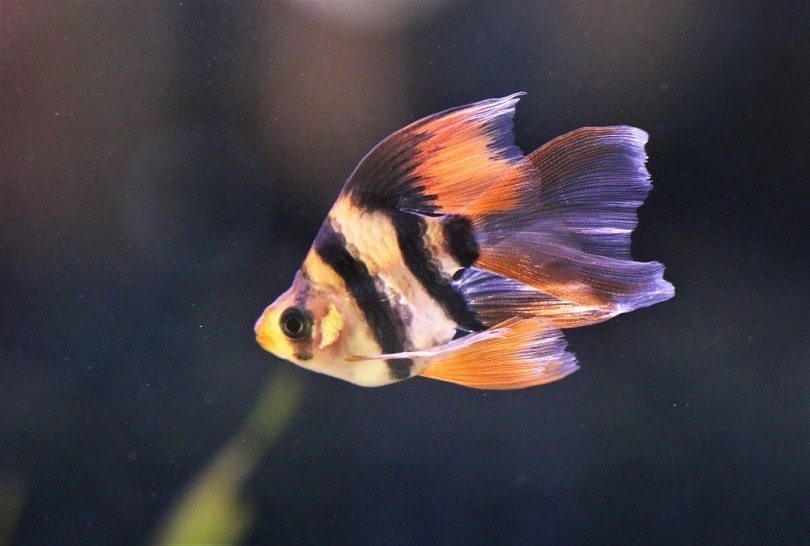
Size
2.5–3 inches
Diet
Omnivore
Temperament
Semi-aggressive, active
The tiger barb is a lovely species of barb species that is beloved by aquarists for their extremely active and social nature. This is a shoaling fish, so you will need at least six tiger barbs to provide your fish with a sense of safety and companionship.
This is a semi-aggressive fish, though, and you can expect to see your tiger barbs working out a “pecking order” within their group. Keeping too few fish together can not only result in stress for the fish but may also lead to one fish being singled out and bullied.
6. Ruby Barb
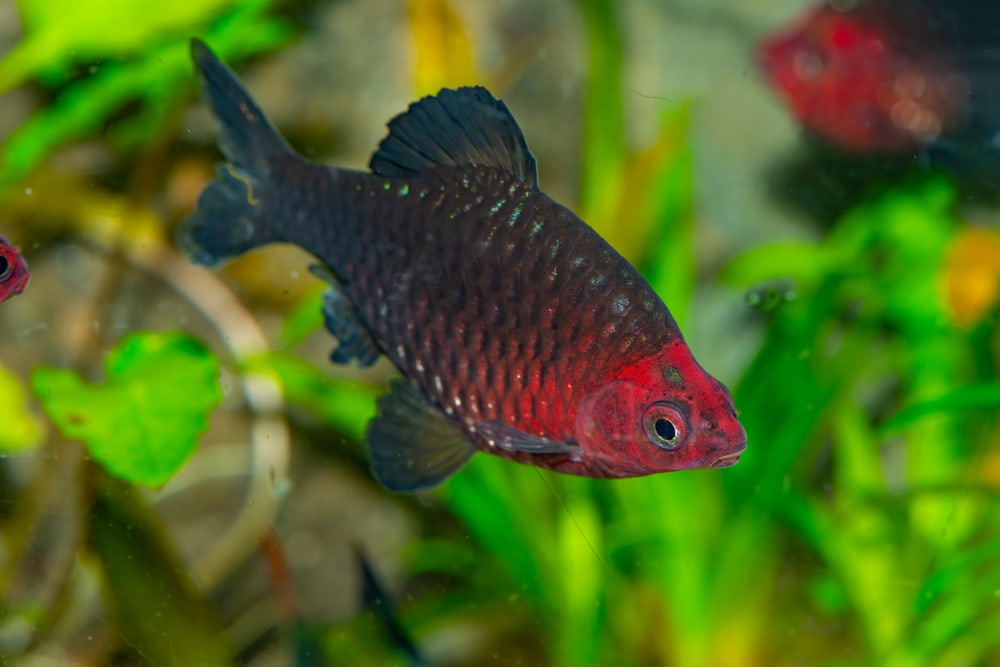
Size
2–3 inches
Diet
Omnivore
Temperament
Generally peaceful, social
The ruby barb (also known as the black ruby barb) is another beautiful barb species that tends to show up in pet stores and fish stores less frequently than its tiger barb cousin. This is an exceptional fish, though, and the bright colors displayed by the males will bring a lot of life and interest to your tank. Keep this shoaling fish in a group of six or more.
Like the tiger barb, you can expect to see your black ruby barbs working out a dominance order within their group. They may nip at long, flowing fins, so it’s best to keep them with tank mates that have shorter fins.
7. Odessa Barb
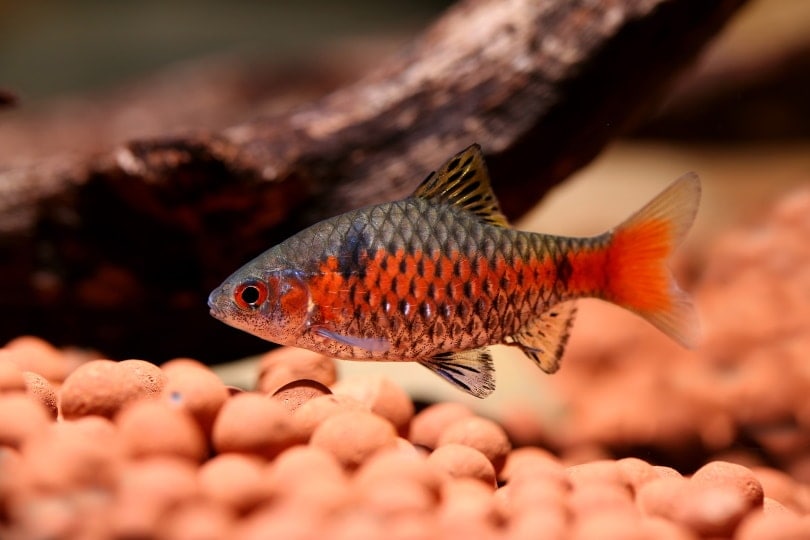
Size
1–3 inches
Diet
Omnivore
Temperament
Generally peaceful, social
The Odessa barb is an interesting species of barb with an extremely unique appearance. Their eye-catching colors and active nature make this fish a fantastic visual point in your tank. Like the other barbs, the Odessa barb should be kept in groups of six or more. A pecking order will be worked out, and if kept in groups that are too small, you’re likely to see a fish being singled out for bullying by its companions. Outside of this, the Odessa barb is a peaceful fish that makes a great addition to a community tank.
8. Black Skirt Tetra

Size
1–3 inches
Diet
Omnivore
Temperament
Peaceful, laid back
The black skirt tetra, also known as the black widow tetra, is an interesting tetra species that can be somewhat shy, so make sure to provide plenty of hiding places in your tank. Keep black skirt tetras in a shoal of six or more fish. Although quite peaceful, this fish has a tendency to be a fin nipper with long-finned tank mates, which can include other black skirt tetras. Keeping a large enough shoal of these fish will reduce the likelihood of this behavior occurring, though.
Like rainbow sharks, black skirt tetras will appreciate having caves and hidey holes to dart in and out of. Make sure there are plenty of options throughout the tank at different levels to ensure all fish have enough space.
9. Congo Tetra
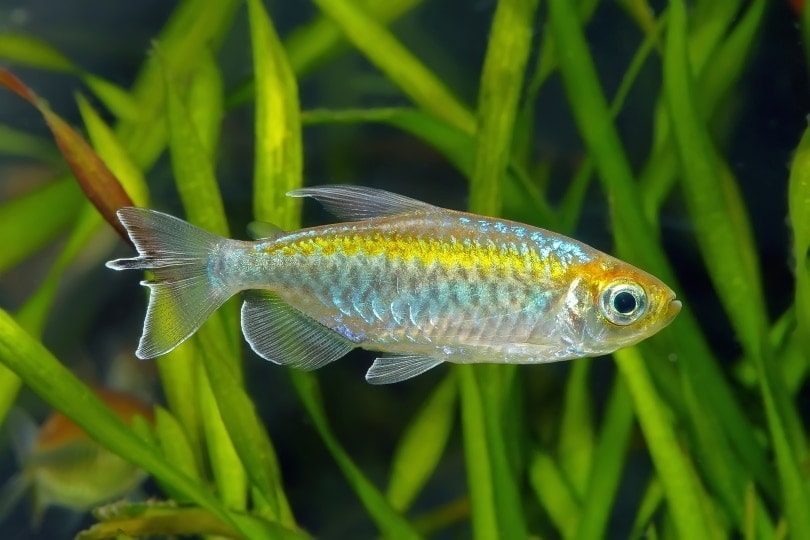
Size
3–4 inches
Diet
Omnivore
Temperament
Peaceful, timid
The Congo tetra may be one of the larger tetra species, but this fish is surprisingly timid. If not kept in a shoal of six or more fish, you can expect extreme shyness and fearfulness, often leading to hiding and darting around the tank in search of hiding places. They are suitable for community tanks, but they don’t appreciate overly active and boisterous tank mates, so stick to some of the calmer species of fish when choosing tank mates for your Congo tetras and rainbow shark.
10. Hillstream Loach

Size
2–3 inches
Diet
Omnivore
Temperament
Peaceful, docile
The hillstream loach is an unusual fish with a flattened appearance, but it can be very interesting to watch. Like most loaches, the hillstream loach prefers to be kept in small groups, and it’s usually recommended to keep at least three together. If two hillstream loaches are kept together, there is a risk that the larger of the two will bully the smaller fish. This behavior aside, this is a very peaceful fish that doesn’t want any trouble with its tank mates and doesn’t appreciate the energy that boisterous tank mates bring. These fish are likely to stay out of the way of your rainbow shark, but they will likely collect in areas of faster water flow in your tank. In addition, they require a very oxygenated environment, and therefore, you would want to also invest in additional aerators for your aquarium.
11. White Cloud Mountain Minnow
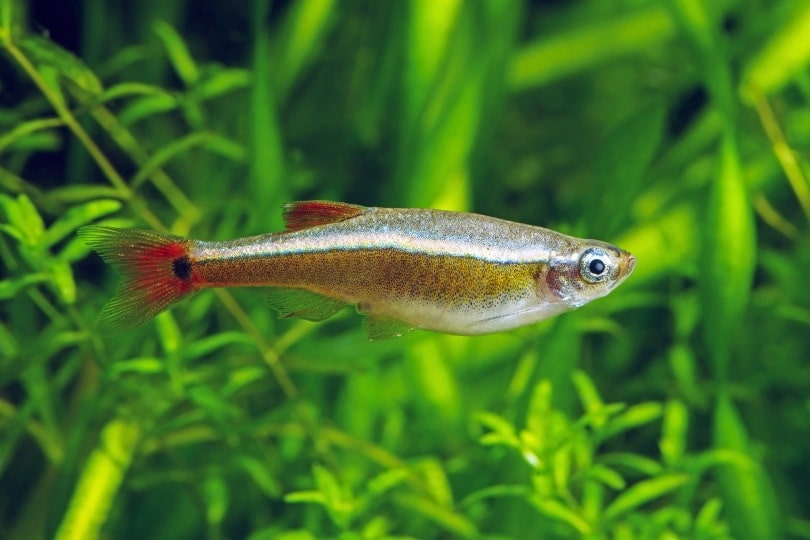
Size
Up to 1.5 inches
Diet
Omnivore
Temperament
Peaceful, docile
The white cloud mountain minnow, also sometimes called WCMM, is a tiny shoaling fish that fits in well in community tanks. They prefer tank mates that are peaceful and calm, and they may be overwhelmed or stressed by fin nippers or overly active tank mates. Due to their small size, there is some level of risk with these fish being eaten by a large rainbow shark. This is primarily a risk if your fish are reproducing, though, since tiny fry will be much more likely to be eaten than full-grown adults.
Plan to have a shoal of at least six to 10 fish, but the more the merrier with the white cloud mountain minnow. The more you have, the more interesting these fish are to watch.
12. Giant Danio
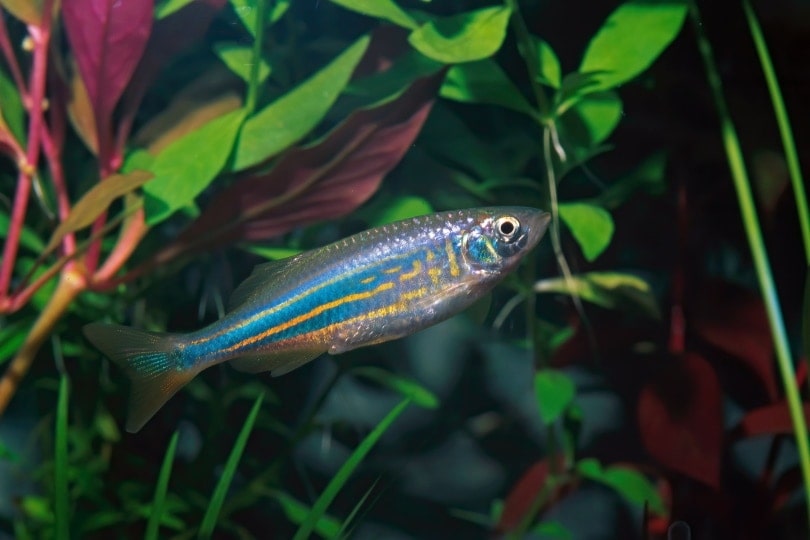
Size
3–6 inches
Diet
Omnivore
Temperament
Generally peaceful, active
The giant danio, as its name implies, is one of the largest danio species, with some fish reaching up to 6 inches in length. While all danio species can be suitable tank mates for rainbow sharks, the giant danio is the best option due to its larger size. This fish is generally a peaceful community fish, but they do sometimes exhibit territorial and bullying behaviors. These undesirable behaviors are especially common when the tank is too small or overcrowded.
Make sure to provide plenty of space and avoid keeping giant danios with more timid tank mates. They should be housed in groups of 5 or more.
13. Dwarf Neon Rainbowfish
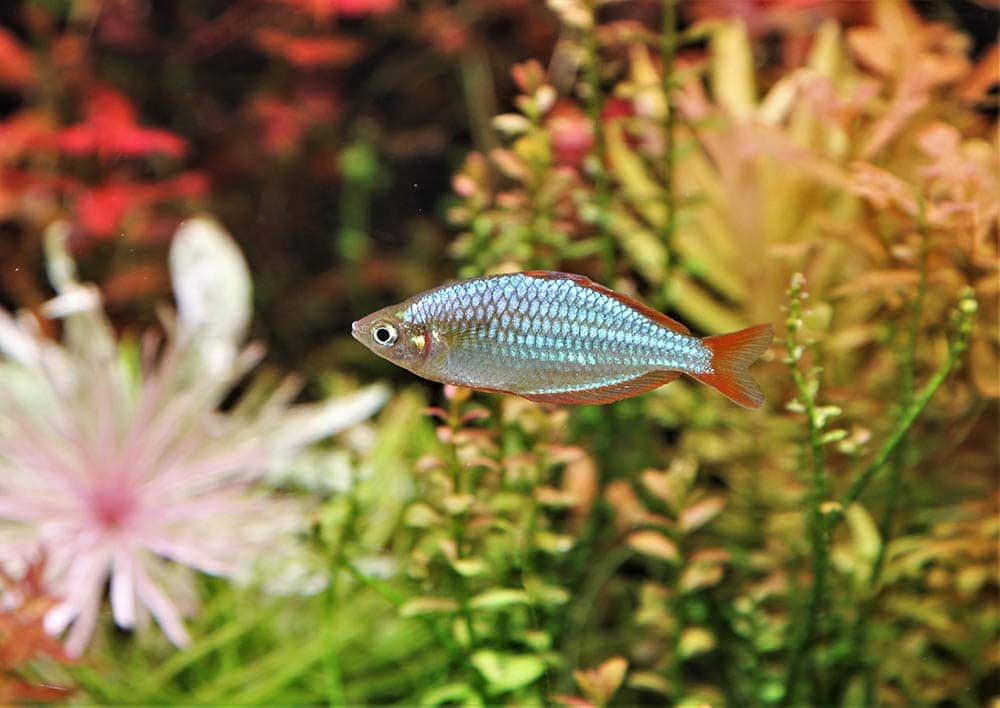
Size
2.5–3 inches
Diet
Omnivore
Temperament
Peaceful, active
The dwarf neon rainbowfish is a shoaling fish that is suitable for community tank environments. Plan to keep at least six to eight of these fish together for them to feel safe, as well as to support more brilliant coloration.
Although peaceful, the dwarf neon rainbowfish is known for eating smaller tank mates. Their small mouth size makes this risk quite low for most tank mates, but tank mates like shrimps, small snails, and fish fry may all fall prey. Their tendency to avoid fights and respect the space of their tank mates makes this a great pick for a tank with a rainbow shark.
14. Boesemani Rainbowfish
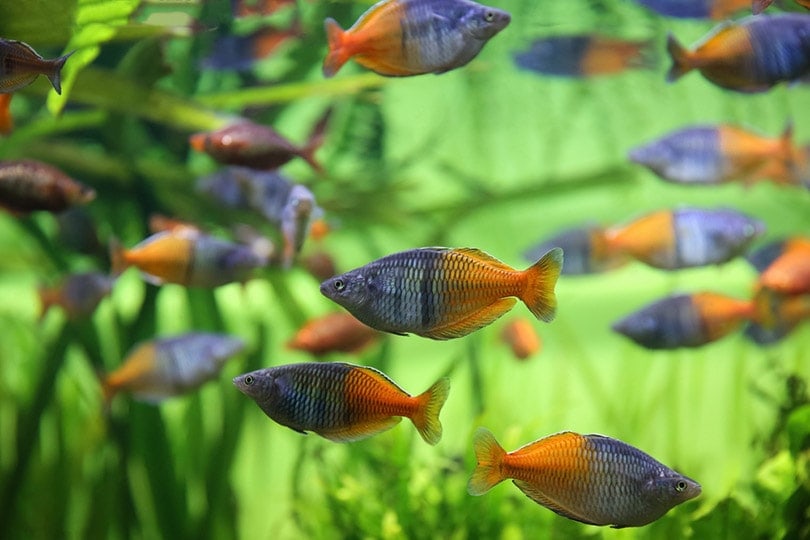
Size
3–5 inches
Diet
Omnivore
Temperament
Peaceful, active
The Boesemani rainbowfish is one of the top picks if you want to bring bright and interesting colors to your tank. When provided with lots of space and large numbers of other rainbowfish, you can expect your Boesemani rainbowfish’s antics to really come to life.
Although a larger rainbowfish species, this fish has a relatively small mouth size in relation to its body, so take this into account when choosing a food. These hardy fish are very social and active, making them interesting to watch for all.
Conclusion
One thing that almost all of the fish on this list have in common is a tendency to be relatively peaceful. Such fish make excellent tank mates for rainbow sharks since they are unlikely to provoke trouble. These fish are also primarily shoaling fish, and having large numbers makes them less likely to be picked on by an ornery rainbow shark. The fish that do have some semi-aggressive tendencies
Featured Image Credit: Aleron Val, Shutterstock


